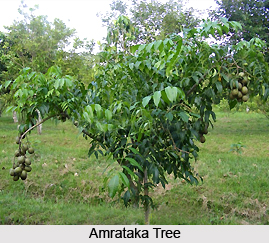 Amrataka tree is famous as wild mango tree and is famed for its medicinal values. Also known as Indian hog-plum tree, amrataka is found throughout India to an altitude of about 1500 m in the Himalayas, usually on well-drained soils, in deciduous, often dry forests. The major botanical names of Amrataka tree are Spondias pinnata (L f.) Kurz, Mangifem pinnata L. f., Spondias acumi-nata Roxb., and S. mangifera Willd. The common name of this tree varies from place to place. Such as in Sanskrit it is famous as Amrataka and Amratakah, in Bengali it is known as Amna, Amra and Ambra whereas in Hindi it is popular as Amara, Amera, Amra and Jangli Aam.
Amrataka tree is famous as wild mango tree and is famed for its medicinal values. Also known as Indian hog-plum tree, amrataka is found throughout India to an altitude of about 1500 m in the Himalayas, usually on well-drained soils, in deciduous, often dry forests. The major botanical names of Amrataka tree are Spondias pinnata (L f.) Kurz, Mangifem pinnata L. f., Spondias acumi-nata Roxb., and S. mangifera Willd. The common name of this tree varies from place to place. Such as in Sanskrit it is famous as Amrataka and Amratakah, in Bengali it is known as Amna, Amra and Ambra whereas in Hindi it is popular as Amara, Amera, Amra and Jangli Aam.
Amrataka is a medium-sized tree with thick, smooth, grey, aromatic bark. Leaves are ovate, and elliptical in shape with a mango-like smell. Flowers of this tree are large and vary from white to pinkish-green colour. The fruits of this tree are edible, stone woody, ovoid and are 4-7 cm long. These are yellow-green or olive-green in colour.
Amrataka is important for its medicinal value. The parts like fruits, leaves and barks are used for various treatments. The juice of both the fruit and the leaves is used to treat earache. The fruits are the astringent and antiscorbutic which are used for treating diarrhoea, dysentery and disease like bilious dyspepsia.
This Indian medicinal plant amrataka is also useful for Ayurvedic practice. In this process, the aromatic leaves and barks are used for the treatment of dysentery. The bark of the Indian hog-plum tree is also useful to prevent diarrhoea, bilious dyspepsia and vomiting. In few regions of Indian subcontinent the paste of the ground bark mixed with water, or of the fruits, is used as a treatment for both articular and muscular rheumatism disease. A decoction of the bark is used to treat gonorrhoea. The roots are equally important for its medicinal use. It is useful for regulating menstruation.
This article is a stub. You can enrich it by adding more information to it. Send your write up at contentindianetzone.com



















